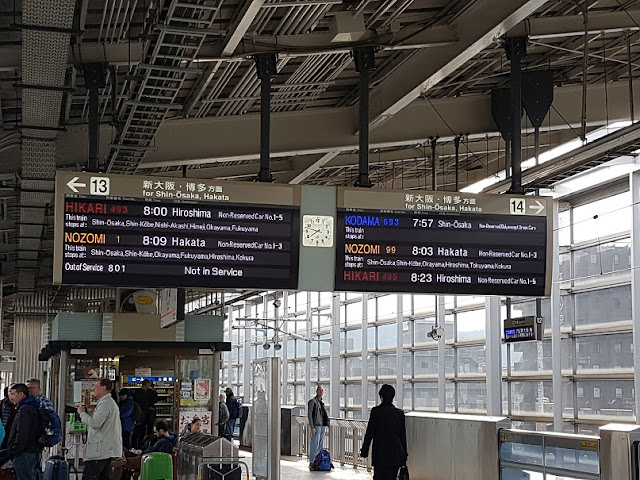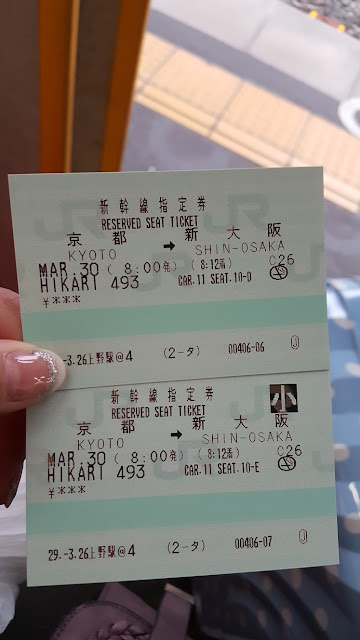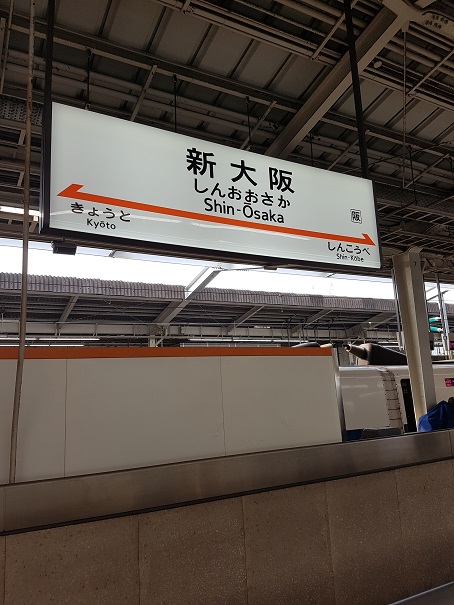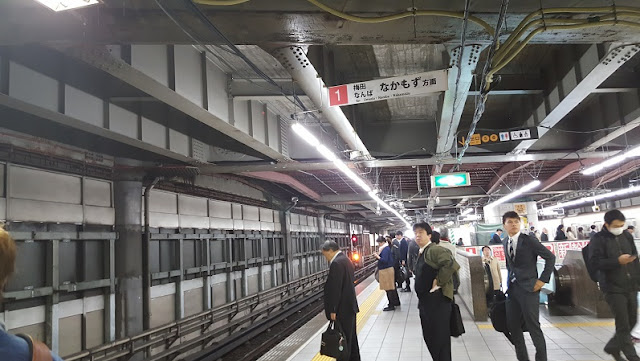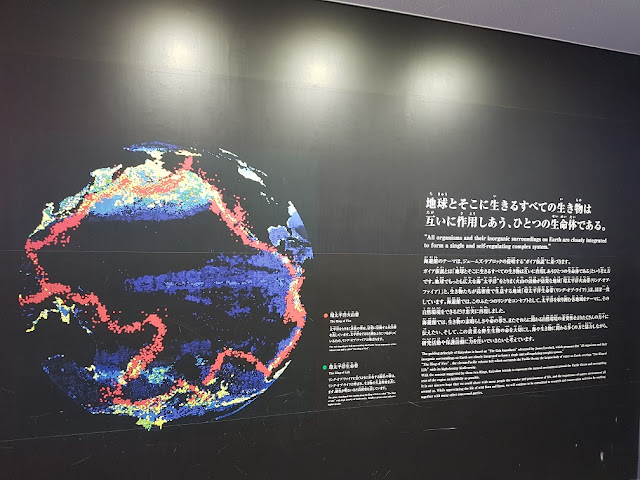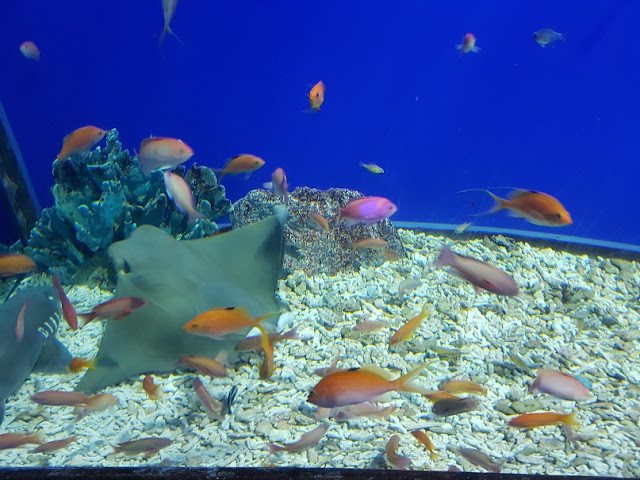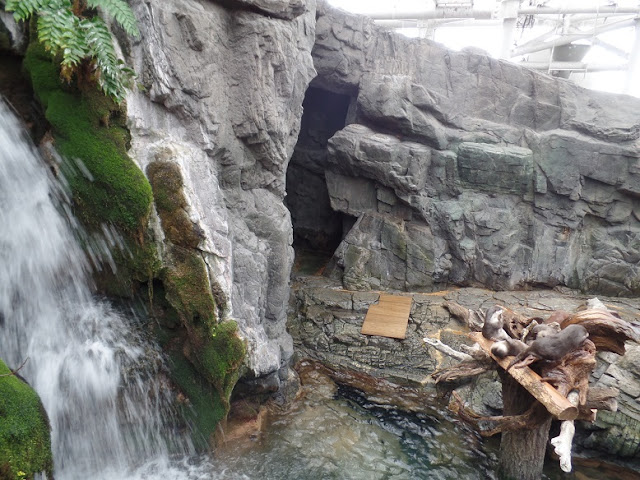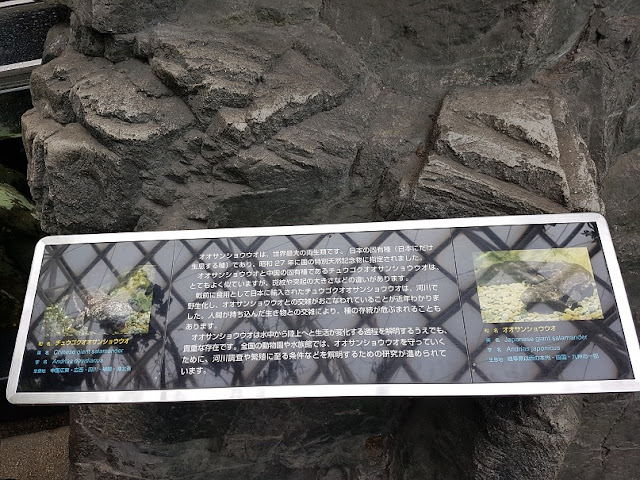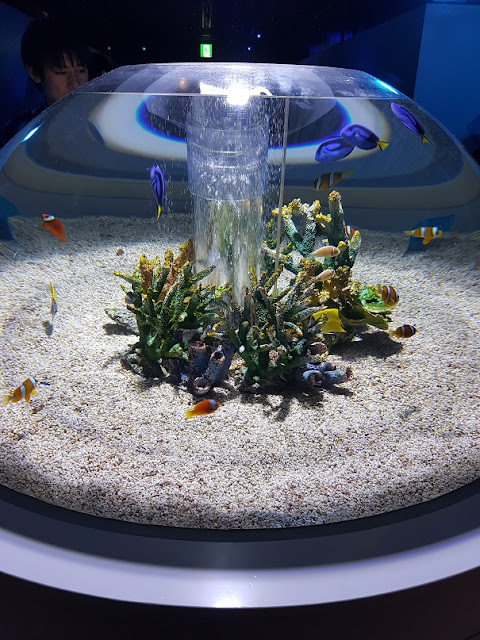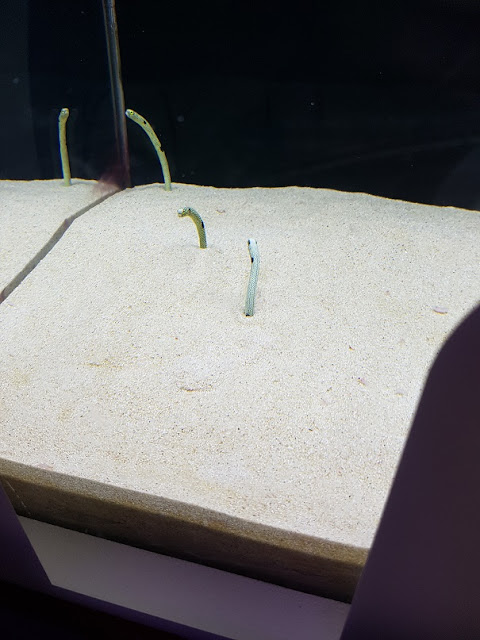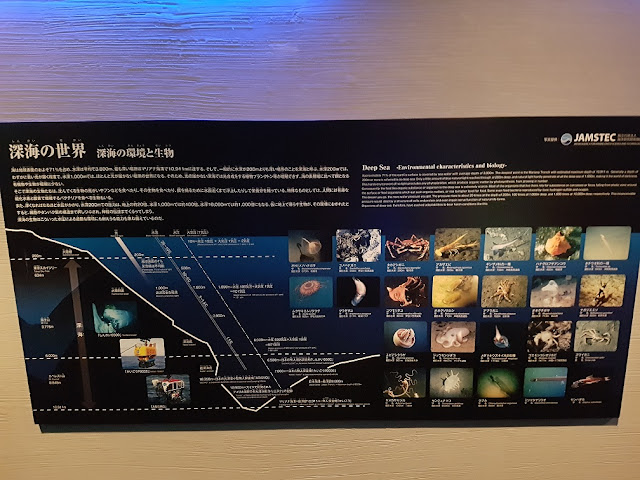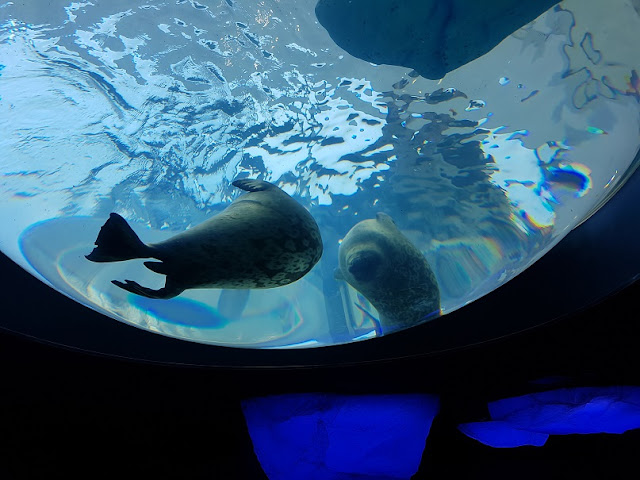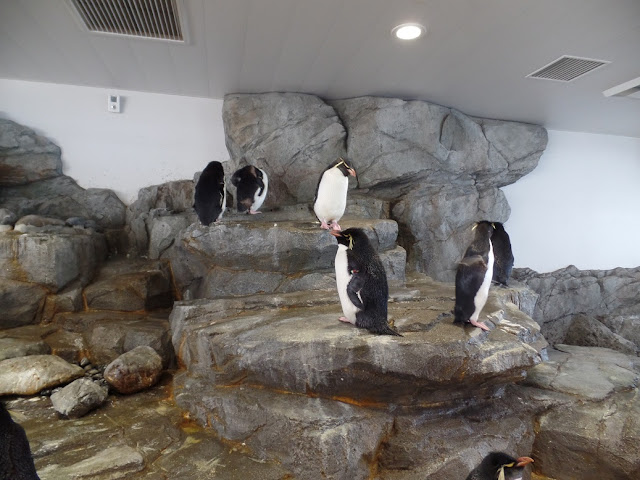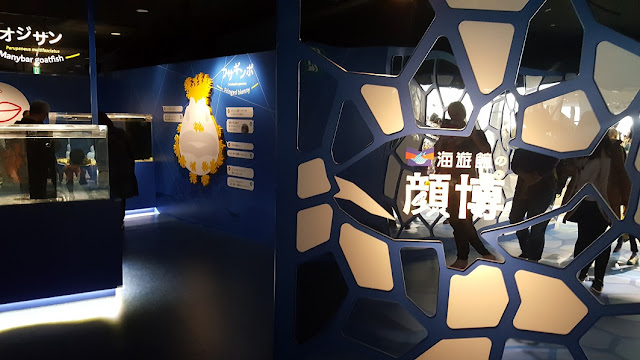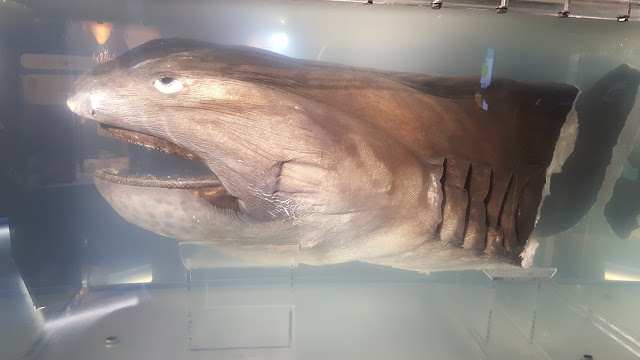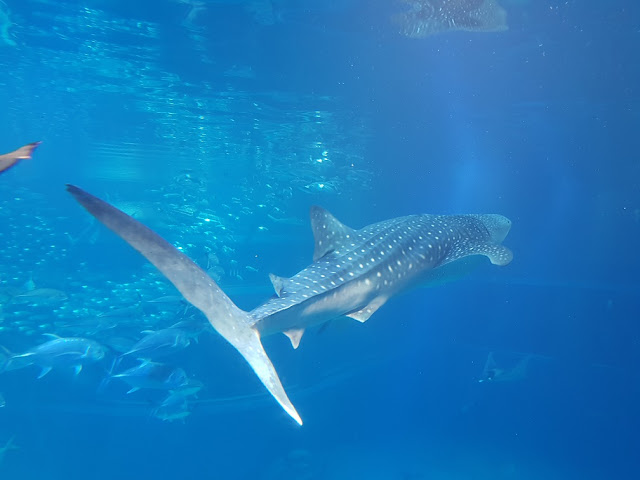From the subway station, we walked for another 100m to New Osaka Hotel Shinsaibashi for check-in.
New Osaka Hotel Shinsaibashi
We had selected
New Osaka Hotel Shinsaibashi primarily for its location, which is within walking distance to Osaka's main shopping belt, Shinsaibashi (心斎橋) and close to subway station. The price of the room was also reasonable, despite located within a prime area.
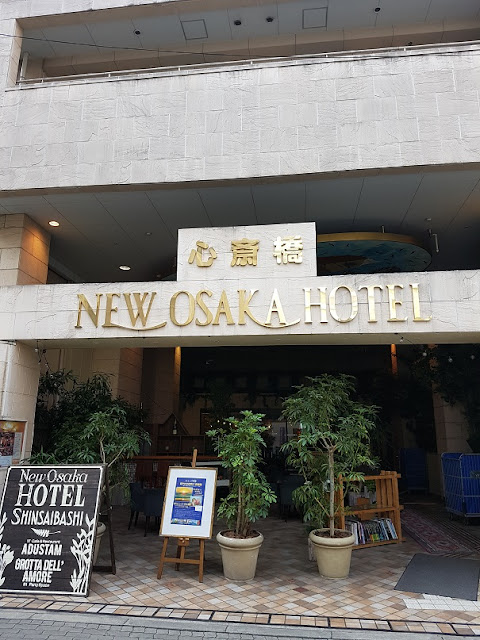 |
| New Osaka Hotel Shinsaibashi |
The room size (double) is small, but typical in most urban cities in Japan, like Tokyo. Although the room size was small, it still comes with the basic amenities like TV, electric kettle, bath tub etc. The room was also generally clean.
 |
| The double room |
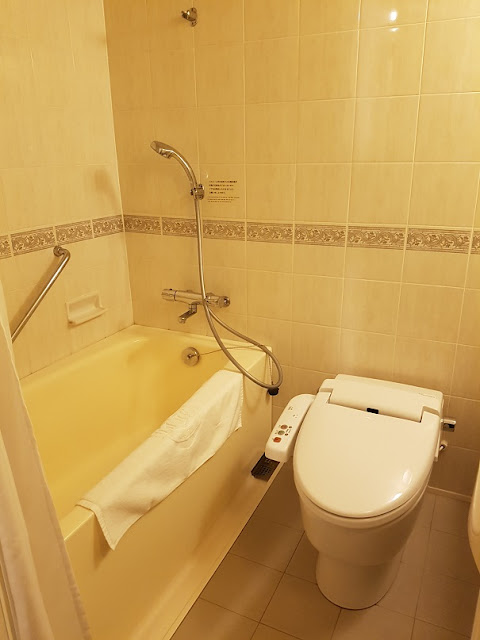 |
| The bathroom |
Osaka Aquarium Kaiyukan (海遊館)
After we had settled our stuff in the room, we were ready to depart for our first attraction of the day, Osaka Aquarium Kaiyukan (海遊館). We headed to Shinsaibashi Subway Station (心斎橋駅) to take the subway to Osakako Subway Station (大阪港駅).
 |
| Osakako Subway Station with advertisement on Kaiyukan |
Moving down to the next level, there's various animals from different regions. These include the playful Sea Otter (Aleutian Islands), Harbor Seal and California Sea Lion (Monterey Bay), Ringtailed Coati (Gulf of Panama), Capybara (Ecuador Rain Forest), Adelie, King and Gentoo Penguins (Antarctica), and Pacific Whitesided Dolphin (Tasman Sea), which attracted the most crowd here.
 |
| Sea Otter |
 |
| Festive feast for the Sea Otter |
 |
| Harbor Seal |
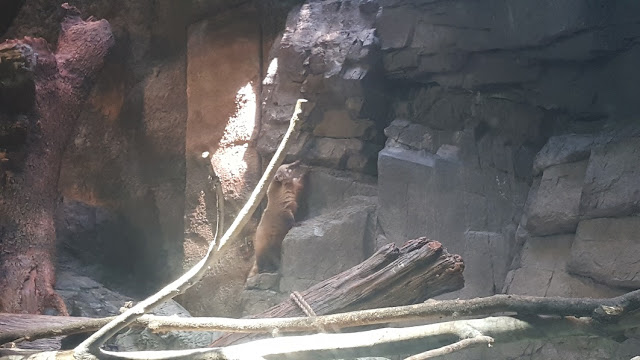 |
| Ringtailed Coati |
 |
| Capybara |
Adelie and King Penguins
Pacific Whitesided Dolphins
Moving down to the 6th floor, this is the most impressive part of the aquarium. This is where the Pacific Ocean exhibit is located, a giant tank spanning from the 6th to the 4th floor. The one that will catch the attention of all visitors is the huge Whale Shark that swims gracefully in the tank. In fact, this was the first time that I ever seen a real Whale Shark in my life.
 |
| Whale Shark |
In addition, visitors could also find other marine life in the tank too, such as Sting Rays and Sharks.
 |
| Shark |
 |
| Sting Rays |
It had been an exciting yet tiring experience touring the entire aquarium, which has so much to see. As it was already lunch time, we exited the aquarium and headed to the nearby Tempozan Marketplace for lunch.
Lunch @ Sakuraya 藤さくら屋 (Naniwa Kushinbo Yokocho なにわ食いしんぼ横丁)
Tempozan Marketplace is a huge 3-storey high retail complex, which comprise of shops, food court, restaurants and cafes, and the Legoland Amusement Park.
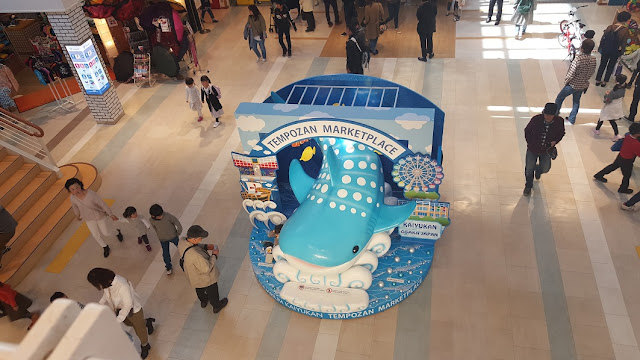 |
| Tempozan Marketplace |
There's really an abundance of choice on the food, where we could find stalls/shops selling fast food (Subway and KFC), Japanese, Chinese, Korean and even Turkish cuisine. After some exploring round, we settled down in the Naniwa Kushinbo Yokocho (なにわ食いしんぼ横丁) sector. Naniwa Kushinbo Yokocho is a food theme park where a number of popular local food are housed under one roof, in a nostalgic setting based on the streets of the 1960s Osaka.
 |
| Naniwa Kushinbo Yokocho |
Sakuraya (藤さくら屋) is one of the many restaurants within the area and we decided to patronise it. Sakuraya specialise on personalised hot pots, but also served other dishes such as steaks and rice sets. We ordered the sirloin steak on hotplate, sliced beef rice set and the pork rice set. The food was served quickly and we also finished fast as well, since we were really hungry then.
 |
| Sakuraya |
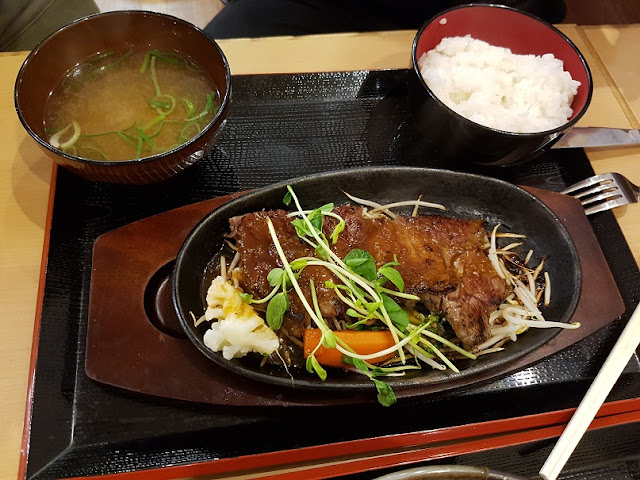 |
| Sirloin steak with rice set |
After the lunch, we spent some more time shopping around before we departed for our next attraction, Osaka Castle (大阪城
).
Osaka Castle (大阪城)
From the Tempozan Habor Village, we walked back to the Osakako Subway Station (大阪港駅) and took the train to Tanimachi Yonchome Subway Station (谷町四丁目駅). From there, it was another short walk to the South Outer Moat of the
Osaka Castle (大阪城), passing by the Osaka Museum of History (大阪歴史博物館) along the way.
 |
| South Outer Moat of Osaka Castle |
The
Osaka Castle (大阪城) is a must-visit attraction for visitors to Osaka. It has great historical significance attached to the unification of Japan during the 16th century, despite that the building we would be visiting was re-constructed and restored several times in the past, with the most recent restoration in 1995. The castle was first constructed in 1583 by Toyotomi Hideyoshi (豊臣秀吉), who used it as his main base and later unify Japan through a series of military campaigns. The Osaka Castle (大阪城) occupies a large compound, with the main tower as the centre of the attraction. Today, the main tower has been converted into a modern museum, which is air-conditioned and has an elevator within it. The entire castle was surrounded by a wide and deep moat, and comprise of other features such as gates, turrets, shrine and parks.
 |
| Map of Osaka Castle |
From the south-western corner of the moat, we crossed the bridge and entered the compound via the Otemon Gate (大手門). After the gate, we could admire the architecture of the stone walls and turrets along the way. The west side of the compound comprise of a big park called Nishinomaru Garden (西の丸庭園), which has several hundreds of cherry trees. It is a very popular place for the locals to visit and picnic during the cherry blossom season. The park requires an entrance fee, and since during our visit the cherry trees were not fully blossomed, we did not visit the park. Nevertheless, there were a few trees just outside the park that blossomed, which we spared no time to take a few good photo shots of it.
 |
| Cherry Blossom at Nishinomaru Garden |
We continued our way towards the main tower, passing through the Sakuramon (桜門). The main tower now comprises of the Osaka Castle Museum (大阪城天守閣), which focus on the history of the castle under Toyotomi and Tokugawa era, life of Hideyoshi Toyotomi (豊臣秀吉), and the Summer War in Osaka.
 |
| Sakuramon |
 |
| Osaka Castle Museum |
After we purchased the entrance tickets, we followed the tour sequence of taking the elevator to the top and tour the exhibitions from the top to bottom. Note that photography is not allowed on the 3rd and 4th floor, which exhibits the historical artifacts. We started the tour at the highest 8th floor, which is the Observation Deck. From here, visitors could enjoy the breeze and scenery surrounding the Osaka Castle.
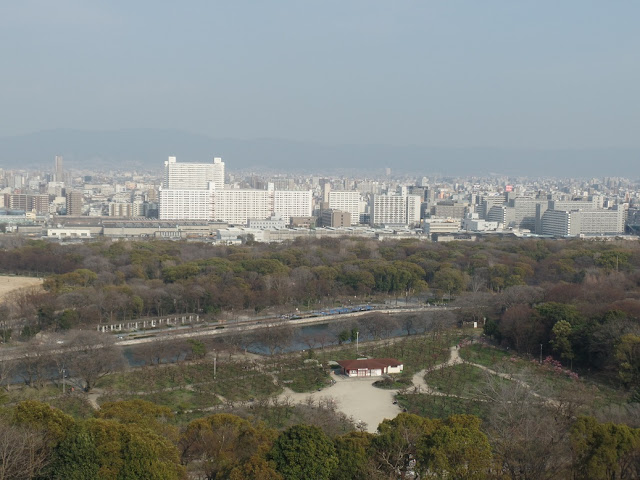 |
| Aerial view of Osaka City |
Next is the 7th floor, where the proper exhibition begins. It focuses on the life of Hideyoshi Toyotomi (豊臣秀吉), the founder of the Osaka Castle (大阪城), from his birth to death. All the exhibits have English translations, so it was easy for international visitors like us to apprehend the content. There're also interactive short videos to introduce the various milestones of Hideyoshi Toyotomi's life.
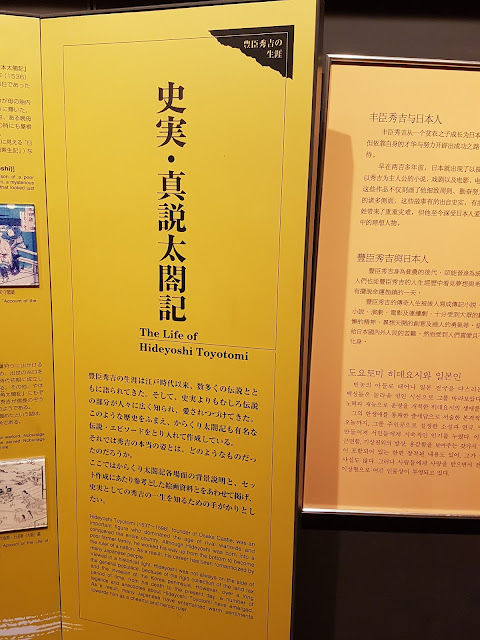 |
| Introduction to life of Hideyoshi Toyotomi |
 |
| Illustration of the main events in Hideyoshi Toyotomi's life |
After this, we went down to the 5th floor (the 6th floor is inaccessible), which focus on history of the Siege of Osaka from 1614 to 1615. The exhibitions revolve around the scenes from "The Summer War in Osaka" folder screen, which depicts the siege of the Osaka Castle by the forces of Tokugawa Leyasu (徳川家康).
 |
| "The Summer War in Osaka" Folder Screen |
 |
| Warlords who participated in the Summer War |
There are detailed information about the various warlords involved in the battle, as well as introduction to the military banners and formations employed during that time. There are also miniatures that re-enact the battle scenes.
 |
| Introduction to the Military Banners |
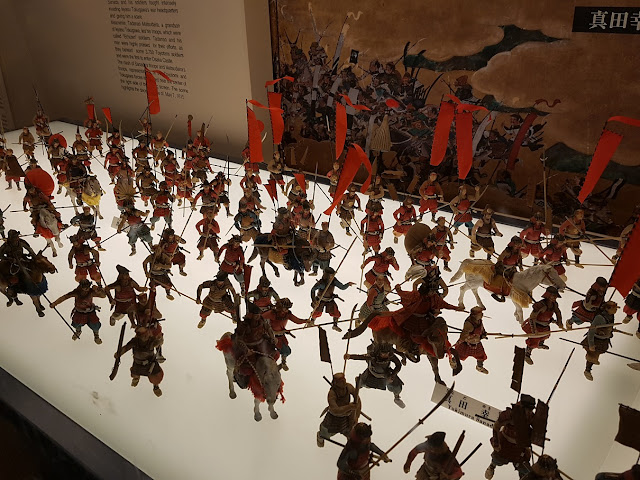 |
| Battle scene with miniatures |
The next 2 floors (4th and 3rd) exhibit various artifacts associated with Hideyoshi Toyotomi (豊臣秀吉) and of his era, such as weapons, samurai costumes, household items etc. There is also information on the reconstruction of the Osaka Castle (大阪城) during the Tokugawa Shogunate era. Visitors could also see the miniature models of the Osaka Castle (大阪城) during the Toyotomi and Tokugawa era.
For the last 2 floors (2nd and 1st floor), the exhibitions cover the history of Osaka Castle (大阪城) during the Meiji period and modern times, facts and information, legends and mysteries of the Osaka Castle (大阪城).
 |
| Mysteries of Osaka Castle |
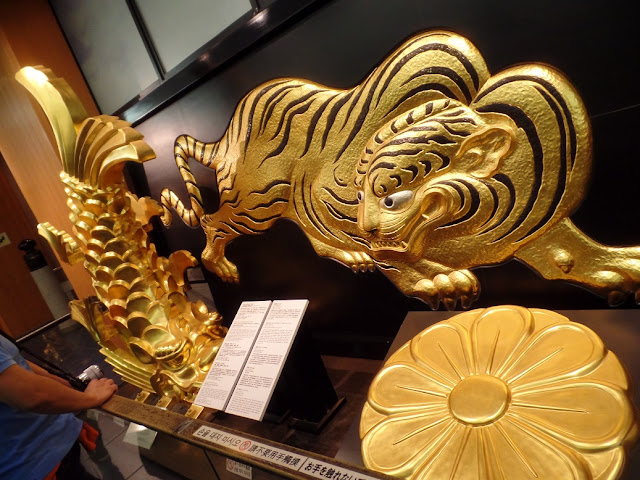 |
| Sculpture |
Shinsaibashi Shopping Street (心斎橋筋)
After we completed the tour of the Osaka Castle Museum (大阪城天守閣), we made our way back to the Tanimachi Yonchome Subway Station (谷町四丁目駅) and took the train to Shinsaibashi Subway Station (心斎橋駅), ready for the shopping frenzy. Shinsaibashi Shopping Street (心斎橋筋) is the largest and most popular shopping belt in Osaka. The shopping street is sheltered and 600m long, in a north south orientation, starting from the Shinsaibashi Subway Station (心斎橋駅) at the north to the Namba Subway Station (難波駅) at the south. Both sides of the street are flanked by boutique shops, restaurants, cafes and large shopping malls. When we arrived there, it was crowded with tourists and locals, which the atmosphere was vibrant and fascinating. We broke up into smaller groups and started to wander and shop along the long street.
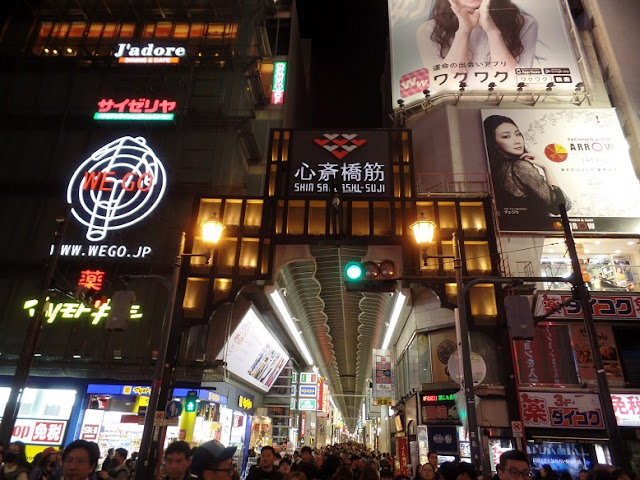 |
| Shinsaibashi Shopping Street |
 |
| "Your Name" (Kimi no Na wa) Themed-Cafe |
Dinner @ Ichiran 一蘭 (Dotonburi 道頓堀)
After the shopping activities, we were all tired and hungry. It was time for dinner and we wasted no time to visit the Dotonburi (道頓堀), located at the southern side and perpendicular to the Shinsaibashi Shopping Street (心斎橋筋). If Shinsaibashi Shopping Street (心斎橋筋) is the shopping paradise of Osaka, then Dotonburi (道頓堀) is the food paradise. There are numerous restaurants selling Japanese and international cuisines. We could also find halal and vegetarian restaurants, which are not common in Japan. The entire street was lighted up with bright colourful neon lights and billboards. Some of the billboards are famous landmarks of Osaka, such as the Glico Man and the mechanised giant red crab of the Kani Doraku Dotonburi (かに道楽 道頓堀本店).
 |
| The famous "Glico Man" billboard at Dotonburi |
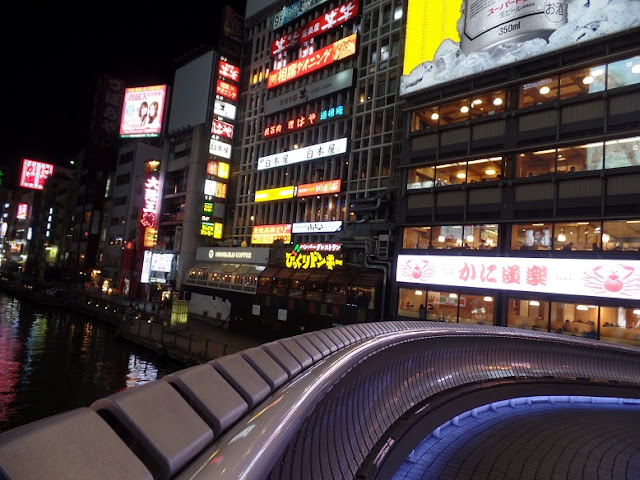 |
| Row of restaurants along the river bank |
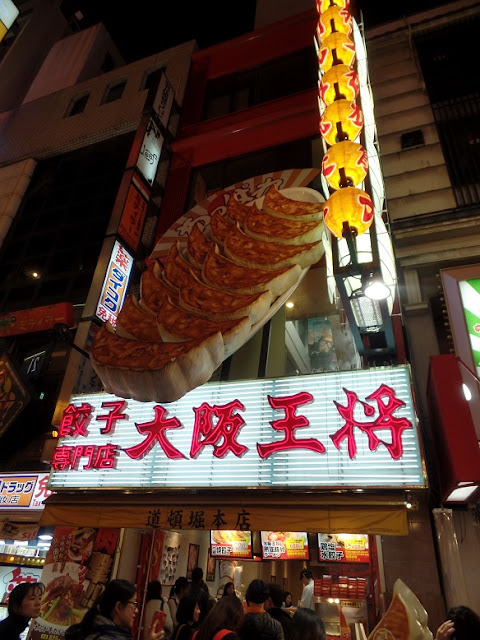 |
| Gyoza Shop |
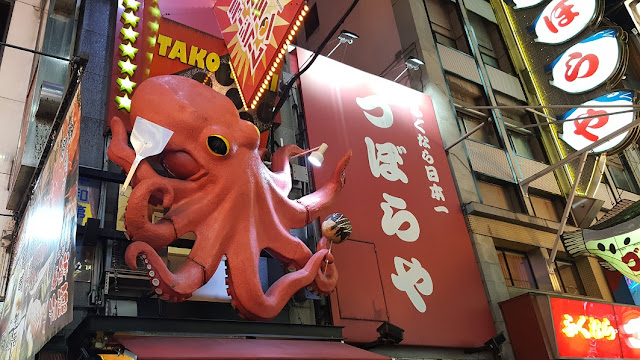 |
| Octopus billboard at a Takoyaki shop |
 |
| The famous giant red crab billboard from Kani Doraku Dotonburi |
Since we were already here, we bought a takeaway crab sushi bento set to fill our hungry stomach first while looking for our dinner venue.
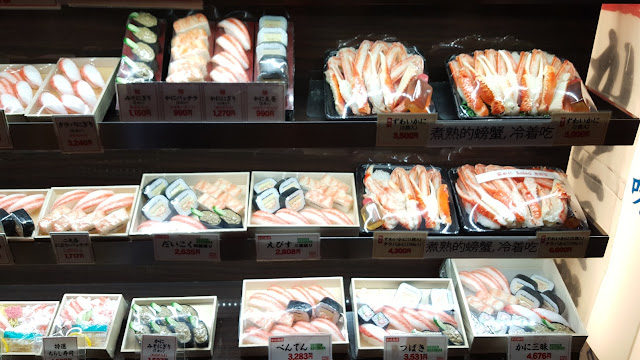 |
| Crab Legs and Sushi from Kani Daraku Dotonburi |
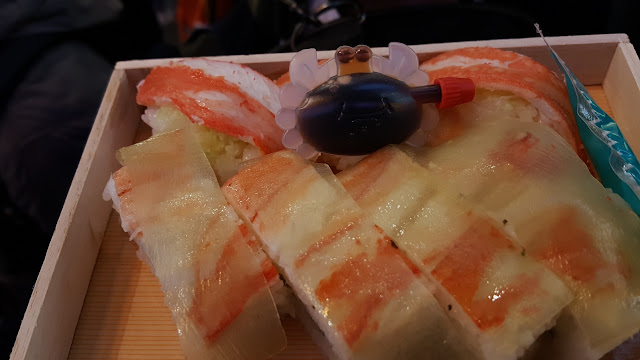 |
| Crab Sushi Bento |
We finally settled down and joined the long queue at Ichiran (一蘭), which is a very popular Ramen restaurant chain in Japan.
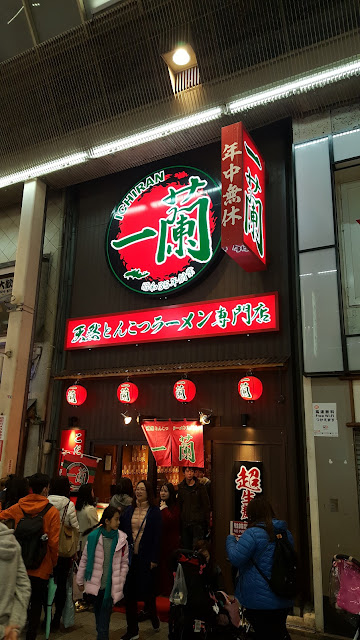 |
| Ichiran |
Like many other Ramen restaurants in Japan, we had to make our order with the vendor machine first. We were also each given an order form (with English translation), which allowed us to customise our Ramen in all ways, such as the noodle texture, flavouring, spiciness, amount of spring onion etc.
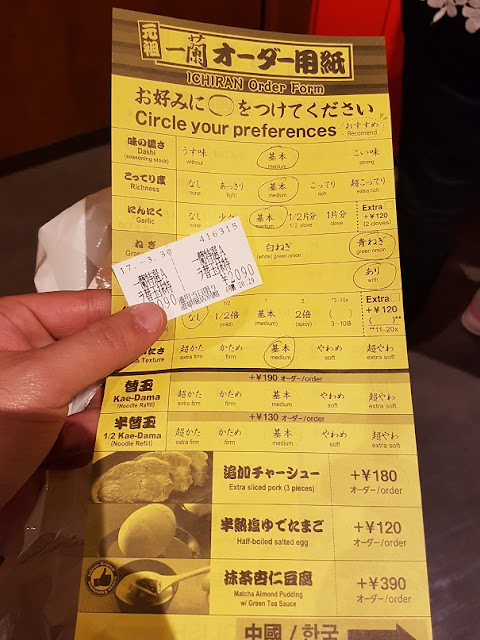 |
| Personalised Order Form |
After making the order at the 1st floor, we were led to take the lift to one of the floor for the seats. The tables were small, so we had to split up our group. After some waiting, the Ramen was served. Most of us ordered the Classic Tonkotsu Ramen, which is the Cha Shu Ramen in pork bone broth. The broth was thick and flavourful, and the pork very tender. This is definitely one of the best Ramen I had ever eaten.
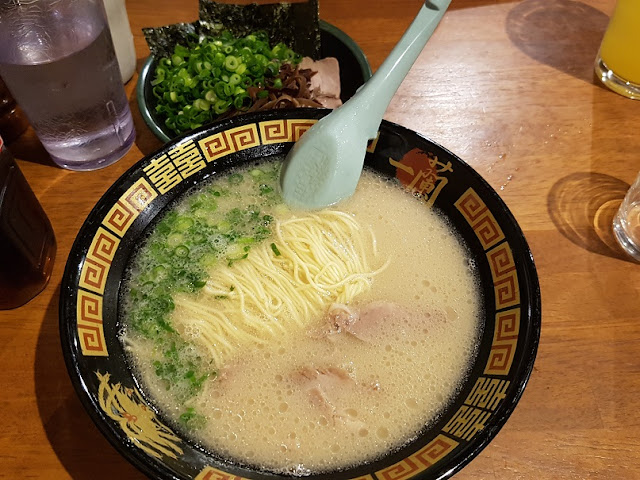 |
| Ichiran's Classic Tonkotsu Ramen |
After the fulfilling meal, we walked back to our
New Osaka Hotel Shinsaibashi via the Shinsaibashi Shopping Street (心斎橋筋), which we had the chance for another round of shopping along the way.
